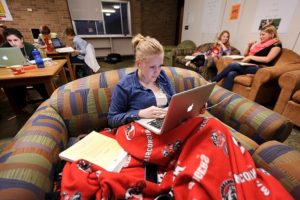Utah Valley University (UVU) is the second largest institution of higher learning in Utah with about 33,000 students and 5,000 faculty members and staff.
 As a key provider of educational opportunity for our region and state, UVU strives to accommodate rapid growth while providing quality programs and services. We prepare our students to succeed in today’s world, and one of the ways we do that is by embracing the use of personal mobile devices to revolutionize the learning process.
As a key provider of educational opportunity for our region and state, UVU strives to accommodate rapid growth while providing quality programs and services. We prepare our students to succeed in today’s world, and one of the ways we do that is by embracing the use of personal mobile devices to revolutionize the learning process.
UVU leadership recognized early on that Bring Your Own Device (BYOD) is not just a “nice to have” feature, it’s become an integral part of the university experience.
Students and faculty members expect to be able to use their personal devices on campus, not just for convenience, but to take advantage of new learning opportunities made possible with mobile technology.
As part of UVU’s IT team, I help to make sure that the process is easy, reliable, and secure.
On our scale, however, this has been no simple task. Every day, thousands of students come to campus with varied devices, expecting access to resources they need on the UVU network – “Wolverine Wifi.”
And it’s not just a one-to-one ratio — students often have three or four devices (smart phone, tablet device, laptop, etc.) that they want to connect to our wireless network. We also get a lot of visitors, from contractors to high school students, who need access to at least some resources while on campus.
In order to keep IT staff from being overwhelmed, as well as provide the kind of quality experience the UVU community expects and deserves, all of this activity had to be automated.
We knew where we needed to go, but we had to find a solution that would take us there. For a long time we relied on outdated Network Access Control (NAC) software.
But in recent years we’ve had such a dramatic increase in the number of students trying to access the network via personal devices that the results were getting painful. Logins were slow, intrusive, and prone to failure — definitely not the experience you want at a major university.
Our IT Help Desk was also dealing with a corresponding increase in their number of calls, with more than 50 percent related to problems logging on to the wireless network.
We approached wireless vendors, but soon realized that we needed a wireless and network-independent NAC solution that was actually designed for BYOD. We evaluated about ten different products, and Bradford Networks’ Network Sentry jumped to the top. It uses technology that automatically identifies every device trying to access the network, the software configuration, and the user.
Another key feature is policy-based access control, which offers the ability to define flexible, highly granular access rules and enforce those rules automatically.
Together, this visibility and control allows tens of thousands of varied users to come to campus with their personal devices and get the network resources they are authorized for, all without jeopardizing security or overwhelming IT staff.
How it works
Network Sentry provides automated network access control that enables UVU students, faculty, and guests to connect their Windows, Mac, or Linux based devices on campus.
The solution is very easy to use and very easy to manage — two essential qualities when you have thousands of users trying to access the campus network via personal devices.
Students and faculty registering for the first time enter their login credentials. Network Sentry then scans their machine, checking for the latest operating system patches and anti-malware software.
Some devices are inevitably infected with malware, so the software ensures they’re bug-free before allowing them on.
If everything is up to date, Network Sentry logs them on to the network and provides access to network resources for which they are authorized. If required software is missing or out of date, the user is instructed to click on a link to self-remediate.
Once they’re compliant, they can access the network (at least their part of it). Subsequent connections are automatic, with Network Sentry identifying the machine, the user, and whether the device continues to comply with access requirements.
The solution is also easy for our IT staff. By clicking or unclicking checkboxes, we can quickly create flexible access policies for each group type based on user role, device status, location, and time.
Network Sentry then enforces the policies automatically. Using this approach, we’re able to quickly, easily, and safely onboard thousands of varied users and devices while greatly reducing IT management.
The software also automates network access for guests and other visitors.
Using the policy controls, we can set up multiple access options for different types of guests such as conference attendees, business guests, and contractors. High school students get access that includes filtering to comply with the Children’s Internet Protection Act.
The impact
Within two months of going live, we had over 20,000 users and 30,000 unique devices registered on the network. The onboarding process is much easier and faster than before, and the number of calls to our Help Desk has been reduced dramatically. In fact, Help Desk calls and walk-ins have been cut in half since the solution went live.
Now that we’re taking full advantage of mobile technology, we’re seeing a more productive classroom experience, a more rewarding student experience, and a better learning experience overall.
Students are also much happier with their network service — and with UVU for providing it. A comment on our Facebook page says it all: “Finally – a good wireless network on campus!”
Looking ahead, our new classroom building and Student Life & Wellness Center will have automated BYOD built in as we continue to integrate mobility into the university experience.
Based on what we’ve seen, automated and secure BYOD really works, and that’s good for our students, our IT department, and for UVU as a whole.
Duke Heaton is a Wireless Network Engineer, Utah Valley University.
- 8 top trends in higher education to watch in 2024 - April 16, 2024
- Defining a path to equitable AI in higher education - April 12, 2024
- Leveraging AI-driven edtech for continuous improvement in higher ed - April 11, 2024

